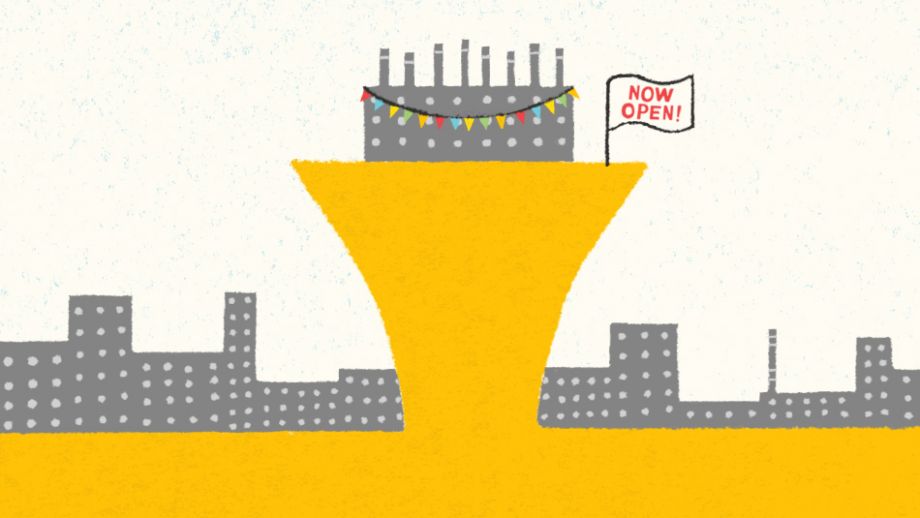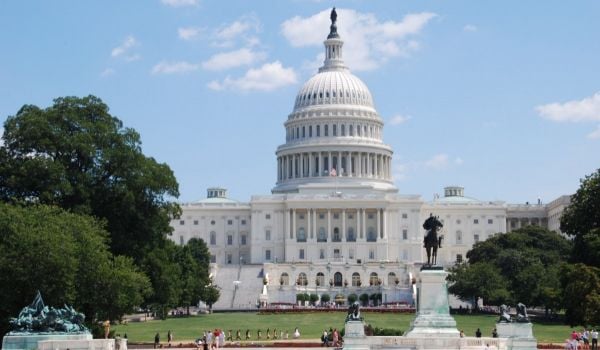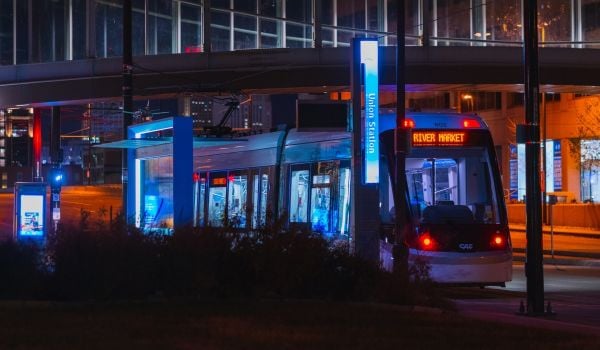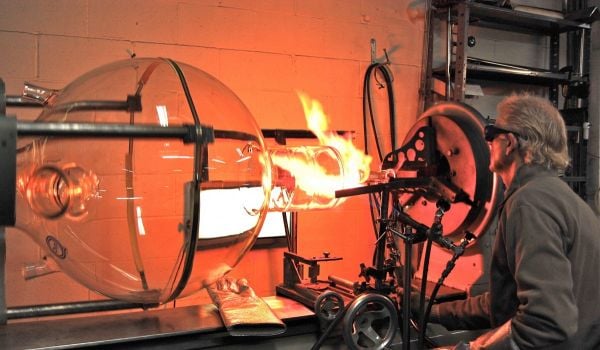The National League of Cities Center for Research and Innovation has joined with Next American City to explore how cities are developing innovative models for tackling complex urban issues and strengthening their local economies. In the coming weeks NLC will feature a series of case studies on foreign direct investment, fiber connectivity, and immigration.
Here, in an adapted version of her Forefront story, Nancy Scola reports on Google’s efforts to make Kansas City the testing grounds for a project dealing with the fastest Internet connectivity in the U.S.
Right now, Kansas City, on both sides of the Kansas-Missouri line, is serving as a test bed for Google’s groundbreaking experiment in bringing ultra-high-speed Internet to homes at an affordable price.
The Internet at such robust upload and download speeds offers up the possibility of immersive education (say, interactive Chinese instruction beamed throughout a school district), health care applications (checking the vital signs of severely ill patients remotely), explorations in arts and culture (historian David McCullough, of Truman, delivering a lecture on the history of Jackson County), wired homes (smart energy meters tied to every appliance), collaborative research (genomic databases shared by scientists the world over), improved municipal services (firefighters equipped with tablets displaying 3D renderings of burning buildings), and much more yet to be imagined. The one gigabit, low-cost, high-speed, ubiquitous connections of the sort offered by the Google Fiber project are, potentially, transformative.
Kansas City hopes to harness Google’s gig opportunity to bring home jobs and innovation. “The way we take advantage of this,” says Mike Burke, co-chair of the Mayors’ Bistate Innovation Team, “is to not just be Google’s beta tester, but the beta tester of everyone who’s got an app or a device.”
For both Google and the region to benefit from the project, they’ll need Kansas Citians to embrace the possibility of being at the leading edge of Internet, partnered with its leading company.
Becoming Google’s Test Bed
In February 2010, Google challenged U.S. cities to compete to be the site of its first attempt at fiber-t0-the-home; fiber optics (read: glass) lacks the bandwidth limits of copper.
The company said it was looking to pull off a small-scale, city-based project that would connect somewhere between 50,000 and half a million people, saying “we hope to learn lessons from this experiment that will help improve Internet access everywhere.” The subtext: that Internet access in the United States is often slow, expensive and, where available, limited to a few providers.
More than 1,100 cities applied. In March 2011, after site visits, data-crunching and closed-door discussions, Google chose Kansas City, Kan. (KCK, population 146,000) and, shortly after, Kansas City, Mo. (KCMO, 463,000).
For many months after the choice was made, Google said little in depth about the project. Mayor Joe Reardon of KCK and Mayor Sly James of KCMO appointed the Mayors’ Bistate Innovation Team (MBIT) of local leaders and charged it with creating a “playbook” for how Kansas City can make the most of the opportunity. For months, MBIT held brainstorming sessions with representatives from the business world, community groups, the educational realm, the arts, the health care sector and elsewhere.
Unburdened by details from Google, says Burke, “we’ve had a year of conversations that I think ever city in the county should have in some way, shape or form.”
One lesson locals took away from that time was that making the most of Google Fiber wasn’t simply about hardware or software, but about a shared reimagining of what it means to be a city of nearly limitless broadband.
The team’s resulting report, called “Playing to Win in America’s Digital Crossroads,” concluded that “a successful Internet economy is 90 percent sociology and 10 percent technology.”
“In short,” argued the leadership team, “we need people to behave like the Internet — navigating a new ecosystem of innovation, collaborating across new networks, building on each other’s ideas, and growing organically.”
Bringing Fiberhoods Online
Google’s first public step was to determine where, exactly, in the Kansas City area Google Fiber would be deployed. “Usually when a provider comes into a community,” says Google Fiber spokesperson Jenna Wandres, “they decide where to build and when to build. With Google Fiber, we’re letting Kansas City decide.”
Google carved the cities into “fiberhoods” and set a quota of $10 pre-registrations — 5, 10 or 25 percent, based largely on geography and population — that would need to be met to turn a fiberhood “green,” a.k.a. make it eligible for Google Fiber service.
Details emerged on the three tiers of service the company was offering. The first package: For $70 a month, Kansas Citians get one gigabit of broadband, a tremendous amount of bandwidth for the price. (To compare, Time Warner Cable’s “Ultimate” Internet package in Kansas City runs $79.99 for 50 Mbps — or 1/200th of a gigabit.) The second package: For $120, Google Fiber customers get cable television service as well. There are other included goodies, like a two-terabyte storage box for saving movies and more.
Importantly, there was a third package: For a $300 installation fee — what Google says it actually costs to run fiber to a home, on average — there is a “Free Internet” option. Customers opting for that connection receive seven years of no-cost broadband service at speeds comparable to today’s high-speed connections. The choice, says Google, was “future proof,” given that the hook-up is upgradeable to one gig service at any time.
Rallying fiberhoods to turn green became much like a political campaign. Dozens of Google canvassers, many hired via Craigslist, set up shop outside schools, libraries and stores. Some drove trucks from which they handed out ice cream sandwiches.
The drive’s slogan was “Let’s Do This For _______,” and one central rallying point was the more than four hundred government buildings, including schools, libraries, police stations and fire houses, that Google would, in “green” fiberhoods, connect to Fiber under its agreement with the cities.
Google’s fiberhood conversion push found help in many quarters. City institutions, public officials, community groups and individual activists all rallied. One Google-produced advertisement highlighted cross-border support. “Let’s do this for Kansas City, Missouri,” said Joe Reardon, mayor of KCK. “Let’s do this for Kansas City, Kansas,” said Sly James, mayor of KCMO.
“It was absolutely genius marketing because they have the communities doing much of their advertising,” says Burke of the mayors’ bistate team.
Google’s approach to deploying Fiber has had its critics.
For one thing, there’s simple logistics. Pre-registration required going online and having both a credit card and a Google Wallet account. The mere six-week registration period led to the critique that Google was ginning up a sense of urgency. More fundamental is the argument that by having neighborhoods self-select, they avoided charges of cherry-picking only the most desirable customers.
As Google sees it, its untraditional demand-driven model — that is, building only where locals have concretely said they want Fiber — is what makes it possible to offer a gigabit connection at rates comparable to existing broadband.
Meanwhile, the Social Media Club of Kansas City, which had gathered local leaders to discuss “Building the Gigabit City,” organized a drive called "Paint the Town Green.” The club, led by president Aaron Deacon, found that some in the city lacked the funds or the means to pay the $10 registration fee, or at least to do it before payday.
Using a Kansas City-made crowd-funding platform called Neighbor.ly, Deacon and the club raised more than $11,000 from both inside and outside the city. The money was put on prepaid debit cards and passed to community groups for pre-registration.
As Deacon sees it, with Google willing to build and deploy a fiber network, it’s reasonable to ask citizens to participate in selling their neighbors on the project. “Is it a little weird?” says Deacon. “Sure. But the fact is that there’s an opportunity to develop something here that doesn’t exist anyplace else.”
As the six-week pre-registration rally moved along, what became clear is that Google and its allies were really engaged in pitching Kansas Citians on two different things.
The first was aimed at those who lacked an Internet connection at all: You live in a broadband world, and need to get online. The second is to those who already had high-speed Internet: It’s worth switching from your existing Internet service provider to tap into the power of the gigabit
Making the Digital Leap
Google conducted a 23-page digital divide study and found, among other things, that 22 percent of Kansas Citians who weren’t using the Internet simply had no interest in getting online. That’s nine points lower than the national average.
But the map on the wall of the Fiber Space revealed that a divide did exist. Many of the neighborhoods to the west of Troost Avenue, traditionally KCMO’s racial dividing line, were green. But many of those east of Troost remained yellow.
The worry was that by providing Internet that is 100 times the speed of today’s broadband, Google might make it even more disadvantageous to be disconnected. For example, under a program called Laptops for Learning, KCK equips high-school students with computers. Those students without a gig connection at home, or broadband at all, might be left further behind. “We don’t want the digital divide to get 100 times wider,” says Michael Liimatta of the community group Connecting for Good.
Added to the mix was the concern that the cities might, by focusing so much attention on Fiber’s potential boons, take their eyes off the more tangible immediate needs of the city’s more challenged areas: Jobs, community services and traditional infrastructure.
Google has had to wrestle with an expectation that its Google Fiber products were meant to be free, akin to the free public WiFi network it offers in its hometown of Mountain View.
Some argue that, spread out over the course of a year at $25 a month, the $300 installation fee isn’t the barrier that it might appear. But there are critical nuances.
Connecting for Good has chosen as a project getting a complex called Rosedale Ridge connected. Apartment renters must rely upon landlords choosing to pay the connection fee for each of their units, a cost that for Rosedale Ridge would run $75,000. The group came up with a plan for connecting the site’s buildings via wireless repeater, but Google decided that that would constitute an unacceptable reselling of its product.
The pre-registration taught Google much, says Wandres. Early on, for example, it structured marketing around certain expected types of humors. But as it saw the Troost divide emerged, the company refocused on targeting neighborhoods and detailing the quality-of-life upgrades that come with having an always-on connection. Google also scrambled to fix a data problem that made it difficult for some living in apartments to register and recalculated quotas to better reflect the housing stock.
“They’re the smartest guys in the world,” Burke says he concluded, “and they’re making it up as they go along.”
The Social Media Club’s Deacon argues that tackling the digital divide question, while enormously important, shouldn’t preclude also figuring out how to make the most of the fact that tens of thousands of homes, and hundreds of libraries, schools, police stations and fire stations, could be connected to a one gigabit fiber network. “That’s the real differentiator,” he says, “the thing that you can’t do anyplace else.”
The rally period wrapped in early September. Thanks, in part, to last-minute pushes, 180 of 202, or nearly 90 percent, of fiberhoods across Kansas City had turned green. The fiberhood map shows far less of a divide than it had even a week earlier. Google says that it is thrilled with that result.
Selling the Gigabit
A truth running through the Google Fiber project is that, at the moment, there’s a limit to what a gigabit of Internet connectivity is good for. Kansas City is no digital island; it’s dependent on an Internet that hasn’t yet been optimized for gigabit speeds.
Google opened up something called the Fiber Space on Stateline Road to demo possibilities. Giant monitors loop sports programming and, through a service called OnLive, video games. At one station, a young staffer shows how quickly you can download YouTube videos, navigate Street View, explore museums via Google Art Project, all on one device. At a telepresence station, a beamed-in nutritionist from the University of Kansas Medical Center offers advice.
Elsewhere in town, a Google billboard brags that “Buffering is so broadband ago.” But the LEGO Harry Potter video game via playing in the Fiber Space is severely pixilated, and the health care display lags before the KU nutritionist begins speaking.
This is the gigabit Catch-22: You need very-demanding technologies to make the most of a gigabit, but you need a gigabit connection to inspire the creation of those same technologies.
It’s what makes Google Fiber-to-the-home look to some like a bet on the future but be derided by others as a gimmick.
Relatedly, and significantly, Google Fiber is not offering commercial service at launch. The company says that its interest has always been in learning how to better connect homes, but leaving Kansas City’s businesses off Fiber may be a major limitation to growing the cities’ Internet economy.
In its early going, the project’s emphasis on cable television and video-streaming have led to criticisms that Google and the cities have failed to show the imagination a gig demands.
“There’s a disappointment,” says Crosby Kemper, chair of the Kansas City (MO) Public Library, “that essentially what you have on offer on day one is essentially what you can get from Time Warner. Downloading movies faster is nice, but there’s nothing particularly transformative about it.”
Where Google Meets Government
After visiting the Fiber Space, as well attending demonstrations and conversations at KU Medical Center’s telemedicine program, Federal Communications Commissioner Ajit Pai praises Kansas City’s willingness to create streamlined, broadband-friendly “rights-of-way” policies for running broadband cables through public lands.
“We need,” writes Pai, “to eliminate regulatory barriers to innovation and investment at all levels of government.”
Pai’s statement speaks to a major debate in the broadband world. Is government standing in the way of broadband? Should it get out of the way completely? Should it seize the mantle itself in the form of municipal networks?
But the facts on the ground in Kansas City suggest that what Mayor Reardon touts in his official biography as “a partnership and new adventure” with Google is something far more complex than the broadband debate generally allows for.
Google has praised Kansas City’s willingness to use its resources to bring fiber to the city, such as lowering some of its infrastructure access fees and streamlining its permit approval process. (By contrast, Google has said that the “regulatory complexity” of California makes Fiber-type projects there extremely difficult.)
KCK and KCMO’s willingness has led to charges that Google is, perhaps unfairly, getting too many concessions from the cities.
Other things attracted Google to Kansas City. Appealing to Google about Kansas City was the chance to work in a variety of environments: Older subdivisions, newer developments, routes that required going underground, routes that required going above ground, some routes where the best path wasn’t obvious.
Additionally, Google was also offered the chance to work in, and learn from, two unique municipal environments. In KCMO, its partner would be a private company, Kansas City Power & Light, a.k.a. KCP&L. On the Kansas side, the utility was the publicly-owned, the Board of Public Utilities.
And for all three players, the gigabit hook-up offers a chance to explore something else: Smart grid technologies, or using high-speed networks to monitor and manage electrical systems — in this case the cities’ energy platforms.
But the facts are that Google’s relationship with KCK and KCMO is unique.
For example, on the Kansas side, Google’s agreement provides for an executive sponsor “at the most senior level of the City” and an in-city team dedicated to the project that is able to provide “on-the-spot exception management” when permits and the like might slow down progress.
And Google won the right to connect, for free, to the electrical portion of utility poles, the same as a public agency would — though it chose to connect to the utility portion used by its competitors. That said, even the $10 connection fee is nearly half the reported rate paid by existing broadband providers.
The local governments aren’t unaware that details of those negotiated packages might raise eyebrows in the offices of the area’s incumbent broadband providers.
“The thing we have to make sure about,” says Mike Taylor, spokesperson for the unified government of Wyandotte County and Kansas City, Kan., “is that we’re not creating an unfair playing field for Time Warner and AT&T, especially when you seen two mayors coming out and being advocates for Google.”
It’s an argument echoed by the incumbent providers themselves: “We’re not afraid of competition,” says Justin Venech, spokesperson for Time Warner Cable. “We’re willing and happy to compete with anyone at any time, and that includes Kansas City. We want to make sure that we’re competing on a level playing field.”
Indeed, those incumbent providers are said to have requested so-called “parity agreements,” or terms comparable to those of Google’s agreements. Those negotiations that are going well, KCK officials say.
But, from the municipal standpoint, Google has in its Kansas City experiment offered the cities something no provider has before. That Google got a friendly package to innovate and build infrastructure and that its competitors are now seeking the same are both positive developments.
“They’ve come into our community and are providing access for our schools and government buildings, for free,” says KCK public affairs officer Edwin Birch. “They’ve been treated like a development project. For us, that’s just a little bit different.”
Bringing Google Fiber to Kansas City isn’t about Google, says Birch, but about a chance to improve the area’s quality of live through innovation. “Google came to us. They selected us. We see it as a once-in-a-lifetime opportunity to connect our community.”
Time Warner Cable and AT&T, he says, hadn’t approached local government before Google arrived to explore how it might partner to benefit the city. “Google being here is good for all of us,” says KCK’s Birch. “They’re creating a dialogue like we’ve never had before.”
As part of that dialogue, Kansas City has been talking with other gigabit cities, like Amsterdam, Barcelona, Moscow, Singapore and Toronto. But given the attention paid to Google Fiber it might be surprising that there’s a city closer to home with lessons to share.
Chattanooga offers its residents a gigabit to the home via EPB, its community-owned electric company, though it sells a gig hook-ups for $299 a month, more for business customers.
The Tennessee city is aggressive in trying to tap the potential of its asset. A summer project called Gig Tank brings “wickedly smart kids to town to play on it,” says Ken Hays, a community liaison on Chattanooga Gig.
Hays says that Chattanooga is “fired up about Kansas City ultimately getting deployed,” as it draws attention to and increases the value of every gigabit connection in the U.S.
With the Google Fiber project, the hope of many is that the low price point — and, frankly, Google’s branding and bravado — open hearts and minds to the possibility of a country that isn’t limited, but empowered, by the broadband available to its people.
What’s Next
Google Fiber has always been an experiment in reengineering how broadband is deployed, and while Google hasn’t hidden its interest in possibly expanding the project to other areas, “we’re really focused on Kansas City,” says Wandres. Already, three small neighboring communities have, after approval by their city councils, been added to the list for future fiberhood qualifications.
The concrete next steps for Google Fiber is to see who converts from a $10 indication of interest to a paying package, and to actually complete the build-out of the fiber connections to homes. Two neighborhoods are scheduled to come online before the end of 2012. The remainder of the construction scheduled stretches through 2013.
The Google Fiber project is no doubt ambitious, and scores of questions remain. Will the economics truly work? Will the fiber networks prove a worthwhile investment for Google and for the people of Kansas City? Will Kansas City make the most of its moment as America’s best-known gig city? Will there be significant innovation around the gig’s potential? Is the Google Fiber model replicable and scalable in other cities?
There’s little doubt, though, that the Google Fiber experiment will expand the universe of thinking about how the cities, towns and rural areas of the United States connect to the Internet of the future. It already has. Google knows a great deal more than it did three years ago about what it means to be a gigabit city. So does Kansas City.
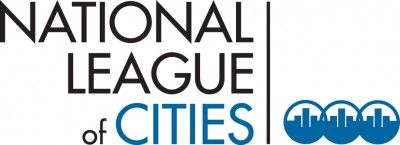
The National League of Cities (NLC) is a resource and advocate for almost 2,000 member cities and the 49 state municipal leagues, representing 19,000 cities and towns and more than 218 million Americans. The NLC Center for Research and Innovation provides applied research and analysis, inspiration and innovative ideas and peer-learning opportunities to help city leaders tackle tough issues and improve the quality of life in their communities.

Nancy Scola is a Washington, DC-based journalist whose work tends to focus on the intersections of technology, politics, and public policy. Shortly after returning from Havana she started as a tech reporter at POLITICO.

